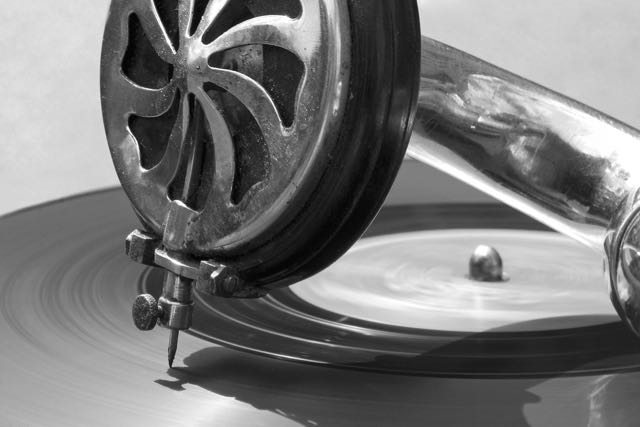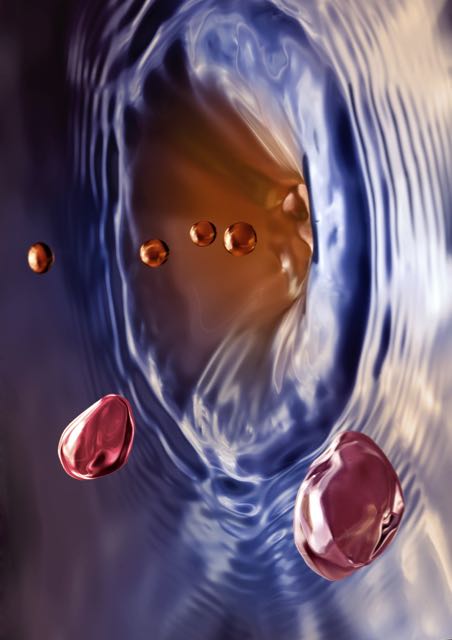A magazine where the digital world meets the real world.
On the web
- Home
- Browse by date
- Browse by topic
- Enter the maze
- Follow our blog
- Follow us on Twitter
- Resources for teachers
- Subscribe
In print
What is cs4fn?
- About us
- Contact us
- Partners
- Privacy and cookies
- Copyright and contributions
- Links to other fun sites
- Complete our questionnaire, give us feedback
Search:
Back (page) in the groove
by Peter McOwan, Queen Mary University of London

Touching, seeing, hearing, tasting and smelling are the main ways we sense the world around us, but when we start to mix and match sensations in humans or machines, finding new ways to produce new experiences, the results can be groovy.
The Historical Record
Before the digital music download, and even before the CD, music came from scratches. The gramophone record was a disc of plastic vinyl with a spiral groove running round its surface. As the record rotated on the turntable a stylus, a sharp needle on an arm, tracked along this groove, from the outside to the centre of the record. Music was coded through the wiggles and bumps on the side of the groove. As the needle ran along it jiggled from side to side feeling the groove like a very thin finger, and this movement was turned into an electronic signal that went, via an amplifier to a loud speaker, and music was made.
These days music is coded directly as a set of computer instructions telling the music player exactly what sounds to produce, leading to high quality reproduction, though the familiar background hiss and crackle and the physicality of the record and turntable means that vinyl has lots of fans even now.
Reach out ... make music in stylus
The Hysterical record
American film director William Castle made his name in the 1950s through a series of horror films with bizarre interactive gimmicks. He wanted new ways to make the cinema experience unique. After all, he was up against that new fangled home TV craze.
To create these unique experiences he filmed his movie 'House on Haunted Hill' in what he called 'Emergo'. The process involved a normal movie but with a rubber skeleton on a wire dangling over the audience that moved in time with the skeleton on screen in the final scenes. Sadly as word spread people came to the cinema to throw things at the skeleton rather than be terrified.
His film 'The Tingler', about a creature that attaches itself to the spinal cord and can only be killed by screaming was filmed in 'Percepto'. That involved attaching aircraft wing de-icer motors to the underside of random cinema seats that buzzed at the right time during the film.
Finally the film '13 Ghosts' was a triumph filmed in 'Illusion-O'. The audience were given a hand held ghost viewer (actually red/blue cellophane glasses). They could look through the red plastic to see the ghosts, or make them vanish by looking through the blue plastic if they were too frightened. The technique exploited complementary colours in the same way as early 3D movies, but like all Castle's ideas it was the showmanship that made it work.

Reach out ... and scare somebody's friend
Growing the grooves for coffee in space
A grumble that crew on the International Space Station have, along with the toilets, is that they can't drink coffee from a cup. They do have a special expresso coffee-making machine, the ISSpresso, developed by the Italian space agency. But micro gravity means that liquids, like coffee, must be held in pouches with a quick release straw type attachment. Otherwise the contents float out and cause problems for the electronics. Not ideal for enjoying a cuppa, especially since that lovely coffee aroma is trapped in a plastic bag.
Enter 3D printing. American researchers working with a high school student have come up with a cup which, while still enclosed, uses surface tension and other simple fluid properties to move the coffee along the cup's surfaces. It comes out in a controlled way without pumps of other mechanics. The clever shape can be 3D printed from a computer-generated plan. In future, the science behind it might also improve the efficiency of other fluid transport systems in space, like life support and fuel tanks.
Reach out ... float free, and relax with a cuppa


